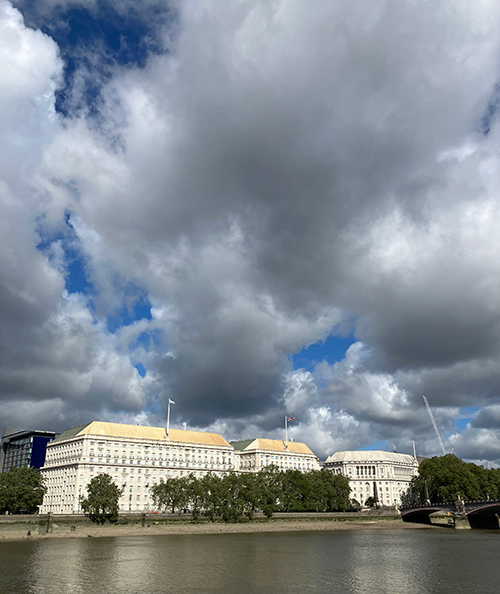
Thames House
MI5 headquarters
 Our headquarters, Thames House, in central London is a Grade II listed building in Westminster, not far from the Houses of Parliament.
Our headquarters, Thames House, in central London is a Grade II listed building in Westminster, not far from the Houses of Parliament.
Design and construction
Thames House was designed by Sir Frank Baines, the Principal Architect of the Government's Office of Works, and constructed in 1929-30. The area on which Thames House was built was devastated by flooding on 7 January 1928.
The design of Thames House owes much to the Imperial Neoclassical style of Sir Edwin Lutyens, the designer of the Cenotaph on Whitehall and the UK ambassador’s residence in Washington DC. It also ties in with the Imperial style of Lambeth Bridge, built between 1930 and1932 and situated opposite Thames House.
The Portland stone façade is decorated with sculptures by Charles Sargeant Jagger, a prominent British sculptor of the early 20th century, who also designed the Royal Artillery Memorial at Hyde Park Corner.
The facade of Thames House displays a number of inscribed coats of arms with Latin mottos that reflect the building's location and history prior to it becoming the MI5's headquarters. These represent the City of Westminster, the City of London and the Port of London Authority. Our own crest is displayed in the flag flown from the roof of Thames House.
The building's impressive riverside location and advanced internal features led to it being described in the 1930s as "the finest office building in the British Empire". Its letting agent described it as "represent[ing] the last word in modern business efficiency." However, the design was not universally praised; the architectural historian Sir Nikolaus Pevsner wrote of his dislike for Thames House's "nasty cheese-coloured roof."
Use of Thames House
Thames House originally consisted of two separate blocks linked by an archway across Page Street. Before the Second World War, a variety of tenants used the building. It was used as an air raid shelter during the war, with local residents sleeping in the basement while bombs fell on Westminster.
By the mid-1980s, Thames House was occupied by chemical company ICI (in the north block) and the Department of Energy (in the south block). The Security Service was, at this time, housed in a number of different buildings around London and new accommodation was needed to provide a better working environment for staff and to house new requirements such as modern IT systems.
The two blocks of Thames House were acquired by the government at the end of the 1980s and were extensively refurbished for use by the MI5. Some major structural changes were made, such the construction of a new link block between the two formerly separate wings of the building. The refurbished Thames House was officially opened on 30 November 1994 by the then Prime Minister, Sir John Major.
Thames House in popular culture
The building that represents the exterior of Thames House in the TV series Spooks (or MI-5 as it was broadcast in the US) is a different building altogether. Spooks' version of Thames House is actually Freemasons' Hall in Great Queen Street, Covent Garden, and the interior depicted in the series is a studio set.
Security considerations mean we do not offer public tours of Thames House. If you’d like to take a look inside, the best way to do so is by getting a job here. Check out our careers page to see if there’s a role for you. The MI5 Instagram account offers some ‘behind the scenes’ insights into who we are and where we work. Check it out here, and follow us on Instagram to find out more.
